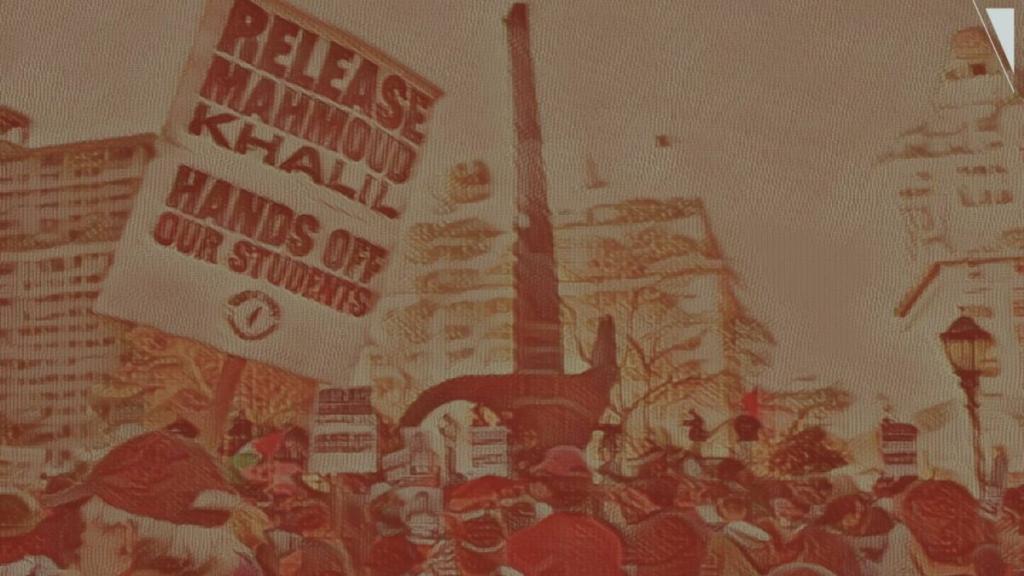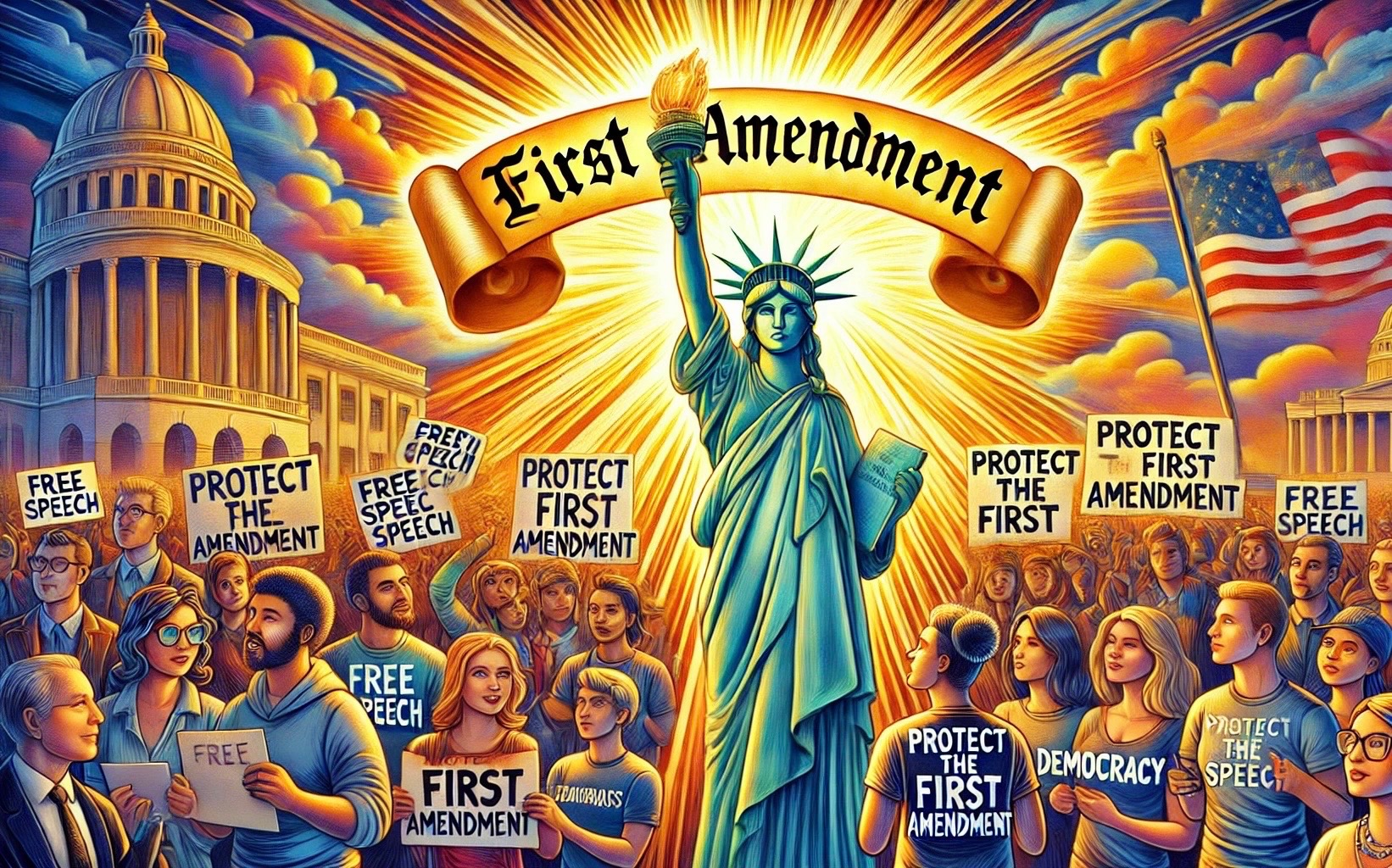On March 8, ICE agents abducted Mahmoud Khalil, an activist in the 2024 Columbia University pro-Palestine campus protests and occupations. Khalil is a legal permanent U.S. resident who holds a green card. Upon his detention, Khalil was transported to the LaSalle Detention Center in Jena, Louisiana without criminal charges. The Trump administration invoked the Immigration and Nationality Act of 1952, a Cold-War-era law allowing the deportation of those deemed to be threats to national security. The abduction and detention of Khalil is the first of what will be many such efforts on the part of a Trump administration determined to shut down campus protest alongside and in conjunction with the administration’s sweeping assault on academic freedom, protest, and diversity efforts on college campuses across the nation. The attacks on higher education, protest, and defenders of Palestine are part and parcel of the right’s war on working class people and struggle.
The abduction and disappearance of Khalil by Immigration and Customs Enforcement (ICE) is part of Trump’s class war on all of us. He aims to divide and conquer the multiracial, multinational, multi-gendered working class picking each group off separately in the hope that we sell each other out and not rally to our mutual defense.
Trump aims to rollback all the gains made by our movements not only in the 1960s but all the way back to the 1930s. He is shredding regulations, gutting institutions, abolishing whole departments, firing workers, overriding union rights and contracts, and threatening the bedrock institutions of our limited welfare state — Medicare, Medicaid, and Social Security.
One of his key targets is higher education, which he delusionally believes is controlled by the Left and wielded against him, his fellow oligarchs, and far-right minions. So, he is targeting Palestinians and the Palestine solidarity movement to carry out a cultural counter-revolution on campuses.
Trump hopes to purge colleges and universities of radicals and socialists, curtail fundamental democratic rights, bust unions, defund and shut down whole programs, and threaten any dissent with repression. Columbia University is ground zero for his counter-revolution.
The attack on Mahmoud Khalil is thus an attack on all of us. Already other Palestinian students from Columbia University have been detained or forced to leave the country. We call on all organizations and unions to unite and demand that the Trump administration immediately release these students and to drop all legal proceedings against Khalil and his fellow university activists.
The crime of protesting genocide
The Trump administration manufactured two claims to justify its detention of Khalil — antisemitism and support for terrorism. Both are lies. To begin with, no one believes charges of antisemitism coming from Trump and his followers, who include Elon Musk and Steve Bannon, with their Nazi salutes, christian zionist antisemites like the pastor John Hagee, and the fascist goons that marched in Charlottesville chanting “blood and soil.”
In reality, Khalil has explicitly and repeatedly denounced antisemitism as anathema to the Palestine solidarity movement. He and all the activists at Columbia, other campuses, and cities across the country have not engaged in antisemitism but in constitutionally protected speech and protest against Israeli apartheid and genocide.
That is in fact part and parcel of the best tradition of Jewish radicalism. That’s why Jews have joined the protests at Columbia and everywhere raising the slogan, “Not in Our Name,” “Never Again is Now,” and “Never Again for Anyone.” It’s also why Jewish students at Columbia rallied to demand Khalil’s immediate release after his arrest.
The movement in solidarity with Palestine is a multiracial movement against all forms of racism that aims for collective liberation and equal rights for all, including Palestinians and Jews, here in the U.S. and in historic Palestine. It stands in the long and noble tradition of abolitionism, antiwar protest, and international solidarity with the oppressed.
And, far from supporting terrorism, Khalil and other activists are protesting Israel’s state terrorism, settler colonialism, and genocide against the Palestinian people. Collectively, we have been calling for a ceasefire, an end to U.S. support for the Israeli war machine, and for peace, justice, and equality among all peoples in historic Palestine.
Trump’s allegations of antisemitism and terrorism are just a smokescreen to obscure what his administration is actually doing. In clear violation of the U.S. Constitution, Trump has deemed it a crime to exercise our constitutional right to speech and protest against Israel’s genocidal war.
Khalil’s “crime” is support for the survival of his people and their struggle for liberation from colonial occupation. Jailed for that, he can only be called a political prisoner of the Trump administration.
Biden’s New McCarthyism
With Khalil’s imprisonment, Trump has dramatically escalated the New McCarthyism. But he did not start the witch hunt. In fact, the Biden administration, Democratic Party mayors, and liberal university bosses were the first to whip up a moral panic over false charges of antisemitism to justify mass repression of Palestine solidarity activists on and off campuses.
They called cops on protestors, arrested activists, suspended SJP chapters, and expelled students. They did so to squelch opposition to their collaboration with Israel’s genocide in Gaza.
Of course, the far-right led by the execrable Elise Stefanik, who has supported the antisemitic “great replacement theory” and is now Trump’s nominee for UN Ambassador, took advantage of the hysteria to hold openly McCarthyite congressional hearings, demanding even more repression by the university bosses. Unsurprisingly, they capitulated, pledging increased censorship, suspensions, and expulsions of any activists, including Jews, who support Palestinian liberation.
Such domestic repression during a war should not surprise anyone. As Martin Luther King famously warned during the Vietnam War, bombs dropped abroad explode at home. Today, Noura Erakat describes how Washington’s support for Israel’s genocide creates a boomerang effect, suppressing democratic dissent here in the US.
That boomerang has hit antiwar protest and radical dissent since the U.S. became an imperialist power at the end of the 19th century. The U.S. always paired foreign intervention with domestic repression from the Palmer raids in the aftermath of World War One to Japanese Internment during World War Two, the original McCarthyite attack on the labor movement amidst the Cold War, the mass repression conducted by J Edgar Hoover COINTELPRO against the Black Panthers at the height of the Vietnam War, and the Patriot Act and surveillance, entrapment, and interrogation of Muslims during the so-called War on Terror over the last two decades. And that is just a short list.
Anticipatory obedience and collaboration
Now faced with an unbridled McCarthyite witch hunt against Palestinians and Palestine solidarity activists, the liberal university bosses and the Democrats have done little to nothing to oppose it and in most cases have collaborated with the Trump administration in carrying it out. Columbia did nothing to protect Khalil despite his repeated calls to administrators.
Even worse, the university responded to Trump’s threat to cut off $400 million in federal funding by expelling 22 students for participating in the protest. No doubt, the university will agree to Trump’s unprecedented demands that Columbia give campus security “full law enforcement authority,” ban masks, impose a more stringent disciplinary system, expel more students, subject entire academic departments to political review, and “reform” its admissions process, no doubt to exclude those Trump deems undesirable.
Trump and his regime will not stop at Columbia. He’s already singled out 60 other colleges and universities for investigation, disciplinary demands, and funding cuts. His aim is to do to all of them what Florida Governor Ron DeSantis did to New College–purge progressive faculty, strip the curriculum of any courses critical of the U.S., and hire right-wing professors to train authoritarian nationalist cadres to carry out his class war on workers and the oppressed.
No one should expect any of the bosses at those institutions to put up a fight. As the AAUP has documented, they’ve all engaged in “anticipatory obedience” to Trump’s dictates, especially against DEI, eliminating programs and removing references to class, race, and gender from course titles and descriptions.
They are obeying not only because they put their bottom line first but also because they only conceded space to the Left on campus and in the curriculum under mass pressure from progressive social movements. Now with those struggles on the defensive, they’re only too happy to take back their concessions to the Left.
For their part, the Democrats have at best put up tepid opposition and at worst joined Trump’s assault. To their credit, 14 Democrats in the House Progressive Caucus signed a letter objecting to Khalil’s abduction and demanding his release, but over 86 refused or neglected to add their names to the list, including Alexandria Ocasio Cortez.
She and others did sign letters from their state delegations. But the establishment embodied by Chuck Schumer reiterated Trump’s false accusations against Khalil while calling for his release and defending his freedom of speech. They have, however, not lifted a finger to follow through on that demand.
No one should expect them to. They support Israel, even as it commits genocide, and they despise anyone who supports Palestinian liberation. As liberal Zionists, they will happily sacrifice their liberalism and support of democratic rights in the service of defending Israeli apartheid.
For that reason, they will not lead the resistance to Trump’s assault on Khalil, Palestinian solidarity activists, and higher education in general. They won’t even resist Trump on other fronts. They are determined to follow James Carville’s idiotic strategy to oppose Trump — roll over play dead in the vain hope that his administration will self-destruct.
But Schumer couldn’t even follow that plan, opting instead to join the Republicans in passing Trump’s new austerity budget. Expecting the Democrats, who nearly unanimously supported Israel’s genocidal war, to defend Palestine solidarity activists and their rights is just naïve. It’s as foolish as expecting a vampire to suddenly have a moral awakening and adopt veganism.
Clear and present danger
The Trump administration, the academic bosses, and the Democratic Party pose a clear and present danger to Palestinians and Palestine solidarity activists on campus. And, even worse, that danger is to all of us.
If Trump can get away with his attack on Mahmoud Khalil, it sets an ominous precedent for further attacks on oppressed people and workers. The threat to all immigrants is obvious: Already engaged in an all-out war on immigrants, Trump will use the abduction of Khalil, who has a green card, as a precedent to threaten others with green cards and visas with arrest, detention, and deportation from the country.
The threat posed by the expulsion of a Palestinian, a person of color, to Black people and other racialized groups is also obvious. So is it to workers’ rights. In its purge of 22 students, Columbia expelled and fired Grant Miner, the elected president of UAW Local 2710, which represents thousands of student workers, the day before they were scheduled to open contract negotiations.
Finally, Trump’s arrest of Khalil and his attack on higher education is a threat to us all. If they can impose McCarthyite restrictions on faculty, staff, and students’ rights to speech, organization, assembly, protest, and strike they will generalize that to other workplaces, cities, and the entire country. To paraphrase Pastor Martin Niemöller’s poem, first they came for Mamoud Khalil, but we are all next in line.
An injury to one is an injury to all
All of our rights and the very existence of our democracy are at stake in the fight for Mahmoud Khalil’s freedom. Trump is hoping that his weaponization of false charges of antisemitism and terrorism can hoodwink people into supporting his assault on Khalil’s rights.
He is hoping that his divide and conquer strategy will work, and we will sell each other out in the vain hope of protecting ourselves. He is hoping that his threat of more repression will dampen resistance.
But already our forces are proving him wrong: Civil liberties groups like the ACLU have rallied to Khalil’s defense; students have protested on campuses across the country; unions have issued statements condemning the crackdown at Columbia; and coalitions have staged mass marches in countless cities demanding his release. We must build this united resistance in defense of our fundamental constitutional rights across the country at universities, workplaces, and cities.
In that struggle, we must recognize the truth of two pivotal slogans: “An injury to one is an injury to all” and “No one is coming to save us.” Beginning with Mahmoud Khalil, we must defend anyone under attack, both because it is right to do so and because we all have an interest in their struggle.
If Trump can take them down, we’re all next in line. That’s why his first line of attack, whether against Palestinians, migrants, trans people, women, people of color or unions, must be our first line of defense. The old labor slogan, an injury to one is an injury to all is now more true than ever before in the history of this country.
In that collective self-defense, we must recognize that liberal university bosses, existing institutions, the court systems, and the Democratic Party will not save us. Of course, we must use every institutional mechanism, exploit every legal means, and secure any and all political allies anywhere we can to advance our demand for the freedom of Khalil.
But we must have no illusions in the court system or the Democratic Party. The courts are stacked against us today, and they have historically protected all the injustices and inequalities of U.S. capitalism from slavery and Jim Crow to mass deportation, restrictions on reproductive justice, and the open shop. Almost every single legal advance was won not through court cases but through mass, often illegal protests and strikes.
The same is even more true of the Democratic Party. It is the party of the capitalist establishment, bankrolled and controlled by the biggest corporations in this country, and utterly committed to advancing the interests of U.S. imperialism as its unrelenting support of Israel through the genocide proved.
It put its steadfast support of Israel as Washington’s regional cop in the Middle East before securing votes from Palestinians, Arabs, Muslims, and young people. In the end, the party’s commitment to Israel helped doom Kamala Harris to defeat.
The Democratic Party support for U.S. capitalism, imperialism, and the New McCarthyism paved the way for Trump to win the presidency and implement his authoritarian nationalist rule. Apart from a handful of exceptions, they have not and will not be reliable allies of the defense of Khalil or the resistance to Trump.
Instead of a popular front with that liberal capitalist party, we must forge a united front of the working class — the Left, social movements, and unions — in defense of Khalil and all our democratic rights, social programs, wages, and benefits. We must trust in our own power to sit in, protest, and strike until justice for Khalil and all of us is won.
We must put his defense at the center of all the agitation this spring on campus and off. We must include the demand for Khalil’s freedom and have Palestinian speakers at all protests on the National Day of Action for Higher Education on April 17.
Unions and migrant justice groups must do the same on May Day. We must end the exclusion of Palestine from the broader social and trade union struggle against Trump and his authoritarian nationalist regime.
If it persists, it will be a chink in our armor, and one that our enemy’s will exploit to divide and conquer us all. If we end the Palestine exception, we can wield together a genuine and inclusive movement for our collective liberation. It is time for us to unite, free Khalil, and free ourselves.






